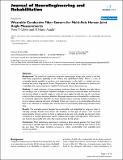| dc.contributor.author | Gibbs, Peter T. | |
| dc.contributor.author | Asada, Harry | |
| dc.date.accessioned | 2010-09-29T17:46:51Z | |
| dc.date.available | 2010-09-29T17:46:51Z | |
| dc.date.issued | 2005-03 | |
| dc.date.submitted | 2004-12 | |
| dc.identifier.issn | 1743-0003 | |
| dc.identifier.uri | http://hdl.handle.net/1721.1/58760 | |
| dc.description.abstract | Background: The practice of continuous, long-term monitoring of human joint motion is one that finds many applications, especially in the medical and rehabilitation fields. There is a lack of acceptable devices available to perform such measurements in the field in a reliable and non-intrusive way over a long period of time. The purpose of this study was therefore to develop such a wearable joint monitoring sensor capable of continuous, day-to-day monitoring. Methods: A novel technique of incorporating conductive fibers into flexible, skin-tight fabrics surrounding a joint is developed. Resistance changes across these conductive fibers are measured, and directly related to specific single or multi-axis joint angles through the use of a non-linear predictor after an initial, one-time calibration. Because these sensors are intended for multiple uses, an automated registration algorithm has been devised using a sensitivity template matched to an array of sensors spanning the joints of interest. In this way, a sensor array can be taken off and put back on an individual for multiple uses, with the sensors automatically calibrating themselves each time. Results: The wearable sensors designed are comfortable, and acceptable for long-term wear in everyday settings. Results have shown the feasibility of this type of sensor, with accurate measurements of joint motion for both a single-axis knee joint and a double axis hip joint when compared to a standard goniometer used to measure joint angles. Self-registration of the sensors was found to be possible with only a few simple motions by the patient. Conclusion: After preliminary experiments involving a pants sensing garment for lower body monitoring, it has been seen that this methodology is effective for monitoring joint motion of the hip and knee. This design therefore produces a robust, comfortable, truly wearable joint monitoring device. | en_US |
| dc.description.sponsorship | National Science Foundation (Grant: NSF 0097700) | en_US |
| dc.publisher | BioMed Central Ltd | en_US |
| dc.relation.isversionof | http://dx.doi.org/10.1186/1743-0003-2-7 | en_US |
| dc.rights | Creative Commons Attribution | en_US |
| dc.rights.uri | http://creativecommons.org/licenses/by/2.0 | en_US |
| dc.source | BioMed Central Ltd | en_US |
| dc.title | Wearable Conductive Fiber Sensors for Multi-Axis Human Joint Angle Measurements | en_US |
| dc.type | Article | en_US |
| dc.identifier.citation | Journal of NeuroEngineering and Rehabilitation. 2005 Mar 02;2(1):7 | en_US |
| dc.contributor.department | Massachusetts Institute of Technology. Department of Mechanical Engineering | en_US |
| dc.contributor.mitauthor | Asada, Harry | |
| dc.contributor.mitauthor | Gibbs, Peter T. | |
| dc.relation.journal | Journal of NeuroEngineering and Rehabilitation | en_US |
| dc.eprint.version | Final published version | en_US |
| dc.identifier.pmid | 15740632 | |
| dc.type.uri | http://purl.org/eprint/type/JournalArticle | en_US |
| eprint.status | http://purl.org/eprint/status/PeerReviewed | en_US |
| dc.date.updated | 2010-09-03T16:22:48Z | |
| dc.language.rfc3066 | en | |
| dc.rights.holder | Gibbs et al.; licensee BioMed Central Ltd. | |
| dspace.orderedauthors | Gibbs, Peter T; Asada, H Harry | en |
| dc.identifier.orcid | https://orcid.org/0000-0003-3155-6223 | |
| mit.license | PUBLISHER_CC | en_US |
| mit.metadata.status | Complete | |
